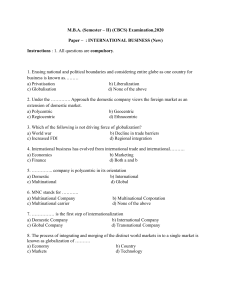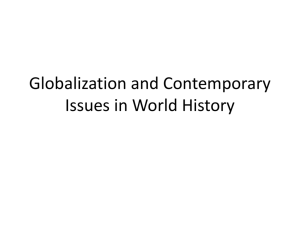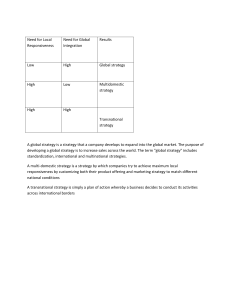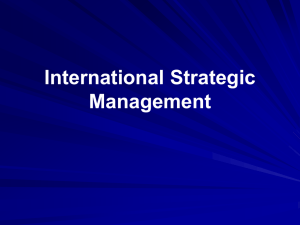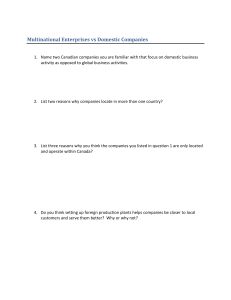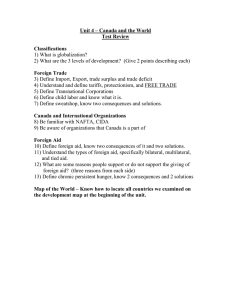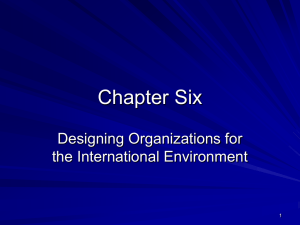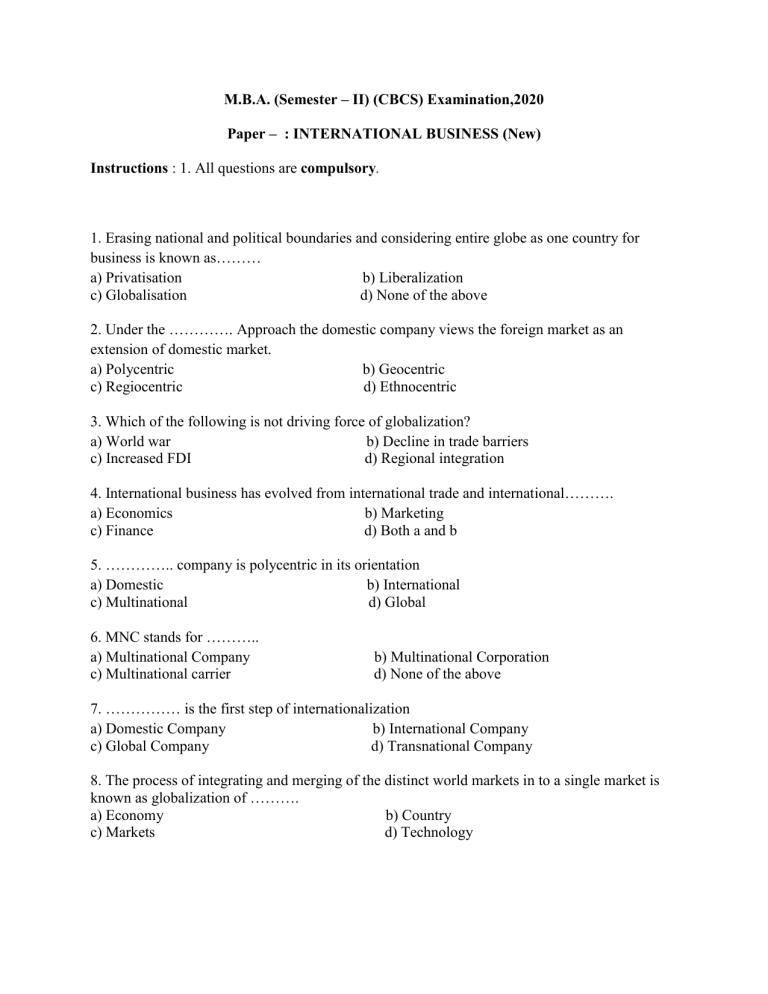
M.B.A. (Semester – II) (CBCS) Examination,2020 Paper – : INTERNATIONAL BUSINESS (New) Instructions : 1. All questions are compulsory. 1. Erasing national and political boundaries and considering entire globe as one country for business is known as……… a) Privatisation b) Liberalization c) Globalisation d) None of the above 2. Under the …………. Approach the domestic company views the foreign market as an extension of domestic market. a) Polycentric b) Geocentric c) Regiocentric d) Ethnocentric 3. Which of the following is not driving force of globalization? a) World war b) Decline in trade barriers c) Increased FDI d) Regional integration 4. International business has evolved from international trade and international………. a) Economics b) Marketing c) Finance d) Both a and b 5. ………….. company is polycentric in its orientation a) Domestic b) International c) Multinational d) Global 6. MNC stands for ……….. a) Multinational Company c) Multinational carrier b) Multinational Corporation d) None of the above 7. …………… is the first step of internationalization a) Domestic Company b) International Company c) Global Company d) Transnational Company 8. The process of integrating and merging of the distinct world markets in to a single market is known as globalization of ………. a) Economy b) Country c) Markets d) Technology 9. The New Economic Policy was introduced in…….. a) 1992 b) 1994 c) 1993 d) 1991 10. The investment of capital by a global company in any part of the world is known as globalization of……….. a) Production b) Market c) Investment d) None of the above 11. Ultimately ………………was replaced by the …………….on 1st Jan 1995 a) GATS, WTO b) WTO, GATT c) GATT, WTO d) IMF, GATT 12. IBRD (International Bank for Reconstruction and Development) also known as a) Exim Bank b) World Bank c) International Monetary fund d) International Bank 13. The first phase of globalization started around 1870 and ended with ….. a) World War I b) World War II c) The Establishment of GATT d) In 1913 when GDP was High 14. Which is the right sequence of stages of Internationalization a) Domestic, Transnational, Global, International, Multinational b) Domestic, International, Multinational, Global, Transnational c) Domestic, Multinational, International, Transnational, Global d) Domestic, International, Transnational, Multinational, Global 15. The Theory of Absolute Cost Advantage is given by a) David Ricardo b) Adam Smith c) F W Taylor d) Ohlin and Heckscher 16. The theory of comparative cost advantage is given by a) David Ricardo b) Adam Smith c) F W Taussig d) Ohlin and Hecksher 17. Which is not an Indian Multinational Company? a) Unilever b) Asian Paints c) Piramal d) Wipro 18. …………………corporation produces in the home country or in a single country and focuses on marketing these products globally or vice a versa. a) Global b) International c) Transnational d) None of the above 19. The —————-company produces, markets, invests and operates across the world a) Global b) International c) Transnational d) Multinational 20. Which of the following is not related with Porter’s Diamond Model a) Demand condition b) Related and supporting industries c) Industry strategy, structure and rivalry d) Factor conditions 21. FDI stands for a) Foreign Direct Investment c) Firm Direct investment b) Foreign Direct Institution d) Firm Delivered Investment 22. The entire world is just like a single country for the company in which approach of IB? a) Polycentric b) Geocentric c) Regiocentric d) Ethnocentric 23. NAFTA is an example of a) Common Market c)Economic Community b) Customers Union d) Free Trade Area 24. A tariff ...................... a) Increase the volume of trade c) Has no effect on volume of trade b) Reduces the volume of trade d) Both a. and c. 25. Which is the currency of European Union a) Euro c) Yen b) Naira d) Dollars 26. Which is the premier forum for facilitating economic growth, co-operation, trade and investment in the Asia- Pacific region? a) SAARC b) NAFTA c)APEC d) BRICS 27. Which of the following was established in July 1956 in order to provide finance to private sector in developing countries? a) IMF b) IFC c) IBRD d) All of the above 28. The tax imposed on imports id referred to as … a) Subsidies b) Quotas c) Tariffs d) Voluntary export restraint 29. ….. is a direct restriction on the quantity of goods which are imported in to a country. a) Tariffs. b) Import quotas c) Voluntary export restraint d) Subsidies 30. Governments in addition to the quotas and other restrictions, use formal and informal …….to restrict imports and boost exports. a) Subsidies b) Quotas c) Administrative policies d) Voluntary export restraint 31………… is a condition that requires some specific fraction of a product imported to be produced domestically. a) Subsidies b) Local content requirement. c) Administrative policies d) Voluntary export restraint 32. The investment made by a company in new manufacturing and/or marketing facilities in a foreign country is referred to as Foreign……. Investment. a) Institutional b) Corporate c) Direct d) Corporate. 33. Which of the following isn’t a reason for Foreign Direct Investment? a) Increase sales and profits b) Reduce costs c) Enter fast growing markets d) No restraints. 34. The first phase of globalization started around 1870 and ended with ….. a)World War I b) World War II c) The Establishment of GATT d) In 1913 when GDP was High 35. The main promoter of trade liberalization was a) GATT c) CEPTA b) NAFTA d) CISA
